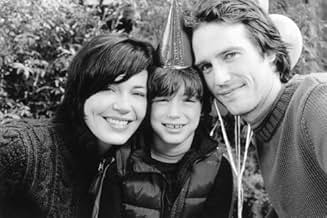A mentally unstable photo developer targets an upper middle-class family after his obsession with them becomes more sick and disturbing than any of them could imagine.A mentally unstable photo developer targets an upper middle-class family after his obsession with them becomes more sick and disturbing than any of them could imagine.A mentally unstable photo developer targets an upper middle-class family after his obsession with them becomes more sick and disturbing than any of them could imagine.
- Awards
- 6 wins & 22 nominations
Paul Kim Jr.
- Yoshi Araki
- (as Paul Hansen Kim)
Andy Rolfes
- Officer Lyon
- (as Andrew A. Rolfes)
- Director
- Writer
- All cast & crew
- Production, box office & more at IMDbPro
Storyline
Did you know
- TriviaAfter the film premiered at the Sundance Film Festival, Robin Williams overheard viewers say that they forgot it was Williams in the lead role 15 minutes into the film. An observation that made Williams proud.
- GoofsWhen Sy is fired from Savmart, his boss Bill allows him to finish the rest of his work week. In real life, terminated employees are generally handed their last paycheck, asked to sign a couple of documents, and are escorted from the premises. Especially since Sy was fired for what appeared to be behavioral issues, he never would be allowed to continue working.
- Quotes
Sy Parrish: And if these pictures have anything important to say to future generations, it's this... I was here. I existed. I was young. I was happy... and someone cared enough about me in this world to take my picture.
- Alternate versionsAn early cut of the film had several differences than the theatrical version.
- The opening Fox Searchlight logo briefly becomes a negative image as it fades out. This is obviously a reference to picture negatives.
- An alternate prologue before the main titles featured a narration by Williams on the red eye effect in human's and animals, while a photo of a family with red eyes, footage of animals with this effect and video of what's happening in the eye when this happens.
- There was also a scene near the end where a police detective reviews the pictures Sy took of Will & Maya at the hotel. In the theatrical version these photos were never shown and it was left in question whether they were actually taken.
- The argument between Sy and the photo machine repair guy was extended.
- ConnectionsFeatured in Anatomy of a Scene: One Hour Photo (2002)
- SoundtracksComing Home
Written by William Aura, Craig Dobbin, and Alain Eskinasi
Performed by 3rd Force
Courtesy of Higher Octave Music
Featured review
Robin Williams, one of the funniest people on the planet, has made a career of playing some very unpleasant people. In this one, he works at a Fotomat (now nearly extinct) and become the stalker of a family that brings their films to him for development. Not only does he stalk them, he knows everything about them, their birthday parties, their fights, their sporting events, etc. Of course, at some point he is going to inject himself into their lives. Fortunately, the scrip writers used some restraint and made this play out the way it should have (I won't' spoil this for you). Suffice it to say that the trip is a scary one and we can't help but feel our flesh creep a bit. We also are made aware of his loneliness and his dysfunctional existence. He is a multidimensional figure, as quirky as one can get. After seeing "The Social Network" recently, I have to also say that we have created a societal voyeurism in our culture. This further shows how fragile our privacy is and how we are willing to sell it to the highest bidder.
Details
- Release date
- Country of origin
- Language
- Also known as
- Фото за годину
- Filming locations
- Brentwood, Los Angeles, California, USA(Yorkin house)
- Production companies
- See more company credits at IMDbPro
Box office
- Budget
- $12,000,000 (estimated)
- Gross US & Canada
- $31,597,131
- Opening weekend US & Canada
- $321,515
- Aug 25, 2002
- Gross worldwide
- $52,223,306
Contribute to this page
Suggest an edit or add missing content




































